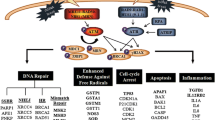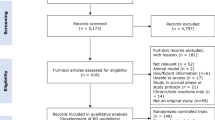Summary
p53 and p21 play an important role in G1/S checkpoint control in response to ionizing radiation. Yet the genetic polymorphisms in these genes have not been investigated with respect to radiation toxicity in patients. We therefore assessed the association between TP53 Arg72Pro, p53PIN3 and p21 Ser31Arg polymorphisms and the risk of acute skin toxicity after radiotherapy in a prospective study of 446 female breast cancer patients (average age 60.3±9.0 years) receiving radiotherapy after breast conserving surgery. The p53PIN3 polymorphism was determined by standard PCR, and TP53 Arg72Pro and p21 Ser31Arg polymorphisms using melting point analysis of sequence-specific hybridization probes. The development of acute skin toxicity (moist desquamation) was modelled using Cox proportional hazards, accounting for cumulative biologically effective radiation dose. Overall, the development of acute skin toxicity, which presented in 77 patients, was not significantly associated with the polymorphisms studied. Risks were however differential by body mass index. Compared to non-carriers, TP53 72Pro carriers had a non-significantly decreased risk of acute skin toxicity in normal weight women (hazard ratio 0.46, 95% CI, 0.18–1.18) but not in overweight patients (hazard ratio 1.07, 95% CI, 0.61–1.89) (p interaction =0.14). Haplotype analysis for the TP53 polymorphisms suggested that effect modification by TP53 72Pro may differ according to the p53PIN3 allele (p interaction=0.06). Furthermore, in TP53 72Pro carriers with p21 Ser/Ser genotype, the occurrence of acute toxicity was reduced in normal weight but not overweight patients. In conclusion, the TP53 72Pro variant may be associated with the development of acute skin toxicity after radiotherapy in patients with normal weight. Large clinical studies are needed to clearly confirm this association.
Similar content being viewed by others
Abbreviations
- ATM:
-
Ataxia telangiectasia-mutated
- BED:
-
biologically effective radiation dose
- BMI:
-
body mass index
- CI:
-
confidence interval
- HR:
-
hazard ratio
- IR:
-
ionizing radiation
- RS:
-
radiosensitive
- RT:
-
radiotherapy
References
Gottlieb TM, Oren M, p53 in growth control and neoplasia Biochim Biophys Acta 1287: 77–102, 1996
Gottlieb TM, Oren M, p53 and apoptosis Semin Cancer Biol 8: 359–368, 1998
Banin S, Moyal L, Shieh S, Taya Y, Anderson CW, Chessa L, Smorodinsky NI, Prives C, Reiss Y, Shiloh Y, Ziv Y, Enhanced phosphorylation of p53 by ATM in response to DNA damage Science 281: 1674–1677, 1998
el Deiry WS, Harper JW, O’Connor PM, Velculescu VE, Canman CE, Jackman J, Pietenpol JA, Burrell M, Hill DE, Wang Y, WAF1/CIP1 is induced in p53-mediated G1 arrest and apoptosis Cancer Res 54: 1169–1174, 1994
Brugarolas J, Chandrasekaran C, Gordon JI, Beach D, Jacks T, Hannon GJ, Radiation-induced cell cycle arrest compromised by p21 deficiency Nature 377: 552–557, 1995
Walker KK, Levine AJ, Identification of a novel p53 functional domain that is necessary for efficient growth suppression Proc Natl Acad Sci USA 93: 15335–15340, 1996
Lazar V, Hazard F, Bertin F, Janin N, Bellet D, Bressac B, Simple sequence repeat polymorphism within the p53 gene Oncogene 8: 1703–1705, 1993
Chedid M, Michieli P, Lengel C, Huppi K, Givol D, A single nucleotide substitution at codon 31 (Ser/Arg) defines a polymorphism in a highly conserved region of the p53-inducible gene WAF1/CIP1 Oncogene 9: 3021–3024, 1994
Wu X, Zhao H, Amos CI, Shete S, Makan N, Hong WK, Kadlubar FF, Spitz MR, p53 genotypes and haplotypes associated with lung cancer susceptibility and ethnicity J Natl Cancer Inst 94: 681–690, 2002
Powell BL, van Staveren IL, Roosken P, Grieu F, Berns EM, Iacopetta B, Associations between common polymorphisms in TP53 and p21WAF1/Cip1 and phenotypic features of breast cancer Carcinogenesis 23: 311–315, 2002
Wang-Gohrke S, Becher H, Kreienberg R, Runnebaum IB, Chang-Claude J, Intron 3 16 bp duplication polymorphism of p53 is associated with an increased risk for breast cancer by the age of 50 years Pharmacogenetics 12: 269–272, 2002
Gemignani F, Moreno V, Landi S, Moullan N, Chabrier A, Gutierrez-Enriquez S, Hall J, Guino E, Peinado MA, Capella G, Canzian F, A TP53 polymorphism is associated with increased risk of colorectal cancer and with reduced levels of TP53 mRNA Oncogene 23: 1954–1956, 2004
Wu MT, Wu DC, Hsu HK, Kao EL, Yang CH, Lee JM, Association between p21 codon 31 polymorphism and esophageal cancer risk in a Taiwanese population Cancer Lett 201: 175–180, 2003
Roh JW, Kim JW, Park NH, Song YS, Park IA, Park SY, Kang SB, Lee HP, p53 and p21 genetic polymorphisms and susceptibility to endometrial cancer Gynecol Oncol 93: 499–505, 2004
Roh J, Kim M, Kim J, Park N, Song Y, Kang S, Lee H, Polymorphisms in codon 31 of p21 and cervical cancer susceptibility in Korean women Cancer Lett 165: 59–62, 2001
Huang SP, Wu WJ, Chang WS, Wu MT, Chen YY, Chen YJ, Yu CC, Wu TT, Lee YH, Huang JK, Huang CH, p53 Codon 72 and p21 codon 31 polymorphisms in prostate cancer Cancer Epidemiol Biomarkers Prev 13: 2217–2224, 2004
Thomas M, Kalita A, Labrecque S, Pim D, Banks L, Matlashewski G, Two polymorphic variants of wild-type p53 differ biochemically and biologically Mol Cell Biol 19: 1092–1100, 1999
Dumont P, Leu JI, Della PA III, George DL, Murphy M, The codon 72 polymorphic variants of p53 have markedly different apoptotic potential Nat Genet 33: 357–365, 2003
Pim D, Banks L, p53 polymorphic variants at codon 72 exert different effects on cell cycle progression Int J Cancer 108: 196–199, 2004
Twardella D, Popanda O, Helmbold I, Ebbeler R, Benner A, von Fournier D, Haase W, Sautter-Bihl ML, Wenz F, Schmezer P, Chang-Claude J, Personal characteristics, therapy modalities and individual DNA repair capacity as predictive factors of acute skin toxicity in an unselected cohort of breast cancer patients receiving radiotherapy Radiother Oncol 69: 145–153, 2003
Cancer Therapy Evaluation Program. Common Toxicity Criteria. NIH 1998, http://ctep.cancer.gov /reporting/ctc.html
Popanda O, Ebbeler R, Twardella D, Helmbold I, Gotzes F, Schmezer P, Thielmann HW, von Fournier D, Haase W, Sautter-Bihl ML, Wenz F, Bartsch H, Chang-Claude J, Radiation-induced DNA damage and repair in lymphocytes from breast cancer patients and their correlation with acute skin reactions to radiotherapy Int J Radiat Oncol Biol Phys 55: 1216–1225, 2003
Wang-Gohrke S, Rebbeck TR, Besenfelder W, Kreienberg R, Runnebaum IB, p53 germline polymorphisms are associated with an increased risk for breast cancer in German women Anticancer Res 18: 2095–2099, 1998
Boltze C, Roessner A, Landt O, Szibor R, Peters B, Schneider-Stock R, Homozygous proline at codon 72 of p53 as a potential risk factor favoring the development of undifferentiated thyroid carcinoma Int J Oncol 21: 1151–1154, 2002
Xie X, Ott J, Testing linkage disequilibrium between a disease gene and marker loci Am J Hum Genet 53:1107–1110, 1993
Terwilliger J, Ott J, Handbook of Human Genetic Linkage Johns Hopkins University Press Baltimore, 1994
Stephens M, Donnelly P, A comparison of Bayesian methods for haplotype reconstruction from population genotype data Am J Hum Genet 73: 1162–1169, 2003
Keshava C, Frye BL, Wolff MS, McCanlies EC, Weston A, Waf-1 (p21) and p53 polymorphisms in breast cancer Cancer Epidemiol Biomarkers Prev 11: 127–130, 2002
Sullivan A, Syed N, Gasco M, Bergamaschi D, Trigiante G, Attard M, Hiller L, Farrell PJ, Smith P, Lu X, Crook T, Polymorphism in wild-type p53 modulates response to chemotherapy in vitro and in vivo Oncogene 23: 3328–3337, 2004
Komarova EA, Kondratov RV, Wang K, Christov K, Golovkina TV, Goldblum JR, Gudkov AV, Dual effect of p53 on radiation sensitivity in vivo: p53 promotes hematopoietic injury, but protects from gastro-intestinal syndrome in mice Oncogene 23: 3265–3271, 2004
Dewey WC, Ling CC, Meyn RE, Radiation-induced apoptosis: relevance to radiotherapy Int J Radiat Oncol Biol Phys 33: 781–796, 1995
Dorr W, Modulation of repopulation processes in oral mucosa: experimental results Int J Radiat Biol 79: 531–537, 2003
Hopewell JW, Nyman J, Turesson I, Time factor for acute tissue reactions following fractionated irradiation: a balance between repopulation and enhanced radiosensitivity Int J Radiat Biol 79: 513–524, 2003
Matsuzoe D, Hideshima T, Kimura A, Inada K, Watanabe K, Akita Y, Kawahara K, Shirakusa T, p53 mutations predict non-small cell lung carcinoma response to radiotherapy Cancer Lett 135: 189–194, 1999
Mazzatti DJ, Lee YJ, Helt CE, O’Reilly MA, Keng PC, p53 modulates radiation sensitivity independent of p21 transcriptional activation Am J Clin Oncol 28: 43–50, 2005
Chang-Claude J, Popanda O, Tan XL, Kropp S, Helmbold I, von Fournier D, Haase W, Sautter-Bihl ML, Wenz F, Schmezer P, Ambrosone CB, Association between polymorphisms in the DNA repair genes, XRCC1, APE1, and XPD and acute side effects of radiotherapy in breast cancer patients Clin Cancer Res 11: 4802–4809, 2005
Bentzen SM, Overgaard M, Relationship between early and late normal-tissue injury after postmastectomy radiotherapy Radiother Oncol 20: 159–165, 1991
Acknowledgements
We wish to thank the staff of the participating clinics for their contribution to the data collection and Belinda Kaspereit, Kati Smit and Peter Waas in DKFZ for excellent technical assistance. We are grateful to all the patients who participated in the study. This work was supported by German Office for Radiation Protection, Project number St. Sch. 4116 and 4233 and in part by the USAMRMC FY01 Breast Cancer Research Program Grant No. DAMD17-02-1-0500.
Author information
Authors and Affiliations
Corresponding author
Rights and permissions
About this article
Cite this article
Tan, XL., Popanda, O., Ambrosone, C.B. et al. Association between TP53 and p21 genetic polymorphisms and acute side effects of radiotherapy in breast cancer patients. Breast Cancer Res Treat 97, 255–262 (2006). https://doi.org/10.1007/s10549-005-9119-2
Received:
Accepted:
Published:
Issue Date:
DOI: https://doi.org/10.1007/s10549-005-9119-2




